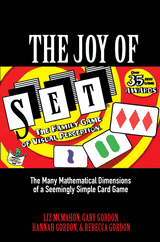The Joy of SETby Liz McMahon, Gary Gordon,
|

|
From the Preface:
SET is one of the most popular games of the last 25 years. Since its release in 1991, it has been recognized repeatedly as an outstanding educational game (the Set Enterprises website lists at least 37 awards spanning more than 20 years.)
The game of SET uses a special deck of cards. Each card has symbols characterized by four different attributes:
- Number: 1, 2, or 3 symbols
- Color: red, green, or purple symbols
- Shading: empty, striped, or solid symbols
- Shape: ovals, squiggles, or diamonds
Initially, 12 cards are placed on the table. Three cards form a SET if they all are the same or all different in each of the four attributes independently. Players scan the cards, the first to see a SET calls "SET!" and removes those cards, which are then replaced. The winner is the person at the end with the most SETs.
A few questions pop up almost right away. How big is the deck? Does a set of 12 cards always contain a SET? If not, what is the minimal amount of cards that is assured of having a SET? It looks like there's a good deal of counting questions, and this is not surprising. What may be surprising is the amount of mathematics, besides the counting, that is relevant to the game of SET. Even more surprising are the depth and the breadth with which related mathematics is covered in the book.
There is even
Fundamental Theorem of SET
Given any pair of cards, there is a unique card that completes a SET with the pair.
Corollary
There are 40 SETs that include a given card.
The Fundamental Theorem is a bridge connecting the game to finite geometry where lines contain three points. The authors found connections to Affine and Coordinate Geometry, even to Linear Algebra and arithmetic modulo 3.
Where is counting, there is probability. Instead of asking whether 12 cards always contain a SET, ask about the probability that 12 random cards contain a SET. What is the expected value of the number of SETs in the initial 12 cards? What is the probability that no cards are left at the end of a game? The book answers these and many more questions.
The book is about the habit and utility of asking questions as much as about the game of SET. Much of the book consists of conversations of three characters such as Stefan, Emily, Tanya, or Shamella, Erin, Tyler, or even (in later chapters) Socrates, Euclid, Theano. The conversations usually raise questions that are subsequently answered by the authors. The book is a pleasant read, with a very accessible the first of the two parts. The second part deals with more advanced topics, but the book is self-contained and requires no upfront formal preparation. The authors mostly count on the reader's curiosity.
If I had to characterize the book in one sentence I'd call it the most tactful introduction to mathematics. There are exercises, but no pressure to solve them. The first part of the book is just a good read. Unless, of course, you want to get deeper understanding of the game and the mathematics involved. The first chapter poses questions that are mostly answered in the remaining chapters of the first part. The authors suggest projects, research projects in particular, based on the material in the book. These are clearly designated for parents and teachers of mathematics. The book shows how budding interest in mathematics can be fostered and developed.
In Preface, authors write that their intended audience includes anyone with a deep curiosity about games. I would expand that by adding middle and high school teachers. If they ever try to enliven their classes or just interaction with curious students, this book is one they may depend on.
The Joy of SET, by Liz McMahon, Gary Gordon, Hannah Gordon & Rebecca Gordon. Princeton University Press, 2017. Hardcover, 320 pp, $29.95 ($23.72 at amazon.com). ISBN 0691166145.
|Up| |Contact| |Front page| |Contents|
Copyright © 1966-2016 Alexander Bogomolny73496889
